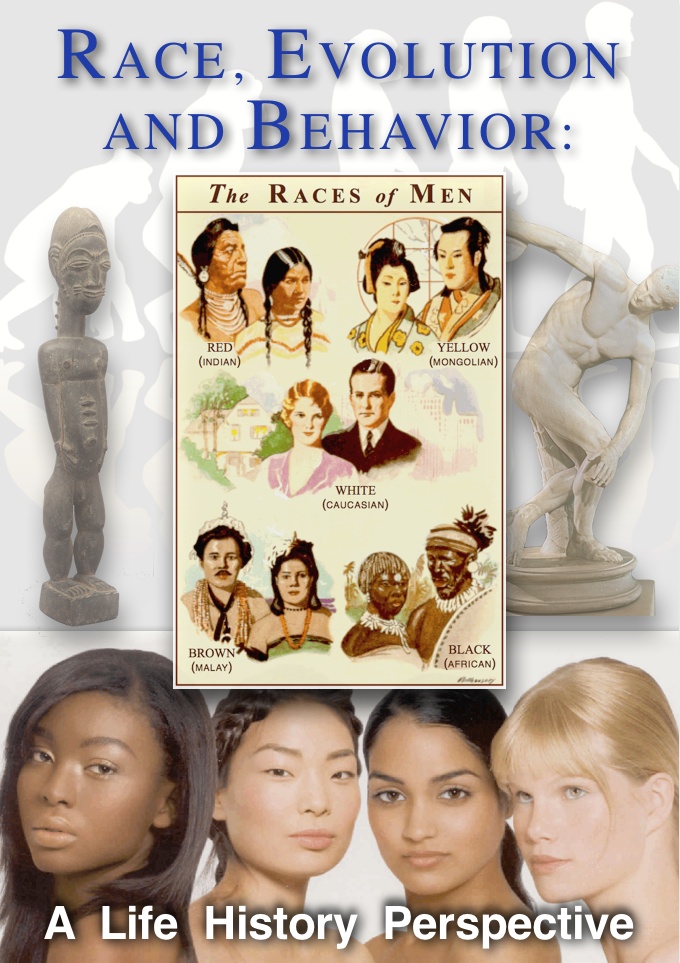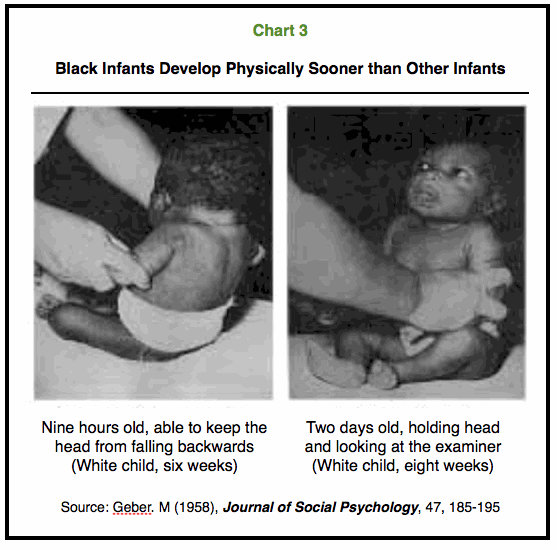RACE, EVOLUTION, AND BEHAVIOR:
A Life History Perspective
[Part 2]
2nd Special Abridged Edition
By Professor J. Philippe Rushton
University of Western Ontario
London, Ontario, Canada N6A 5C2
Author
J. Philippe Rushton is a professor of psychology at the University of Western Ontario, London, Ontario, Canada. Rushton holds two doctorates from the University of London (Ph.D. and D.Sc) and is a Fellow of the John Simon Guggenheim Foundation, the American Association for the Advancement of Science, and the American, British, and Canadian Psychological Associations. He is also a member of the Behavior Genetics Association, the Human Behavior and Evolution Society, and the Society for Neuroscience. Rushton has published six books and nearly 200 articles. In 1992 the Institute for Scientific Information ranked him the 22nd most published psychologist and the 11th most cited. Professor Rushton is listed in Who’s Who in Science and Technology, Who’s Who in International Authors, and Who’s Who in Canada.
[Page 5]
Contents
Preface 6
1. Race is More Than Skin Deep 7
Race in History
Race in Today’s World
Why Are There Race Differences?
Conclusion
Additional Readings
2. Maturation, Crime, and Parenting 13
Maturation
Crime
Personality, Aggression, and Self-Esteem
Parenting and Out-of-Wedlock Births
Longevity and Population Growth
Conclusion
Additional Readings
3. Sex, Hormones, and AIDS 18
Sexual Behavior and Attitudes
Sexual Physiology and Anatomy
AIDS and HIV
Conclusion
Additional Readings
4. Intelligence and Brain Size 22
Culture Fair Tests
Intelligence and Brain Size
Race Differences in Brain Size
Magnetic Resonance Imaging
Brain Weight at Autopsy
Measuring Skull Size
Measuring Living Heads
Summarizing Brain Size Differences
Conclusion
Additional Readings
5. Genes, Environment, or Both? 28
Heritability Studies
Adoption Studies
Race and Heritability
Trans-racial Adoption Studies
Heritabilities Predict Racial Differences
Regression to the Average
Conclusion
Additional Readings
6. Life History Theory 34
r-K Life History Theory
Race Differences and r-K Strategies
Testosterone — The Master Switch?
Conclusion
Additional Readings
7. Out of Africa 39
The Evidence
Geography and Race
Conclusion
Additional Readings
8. Questions and Answers 42
Is Race a Useful Concept? (Chapter 1)
Are the Race Differences Real? (Chapters 2 through 5)
Is the Relationship Between Race and Crime Valid? (Chapter 2)
Is the Relationship Between Race and Reproduction Valid? (Chapter 3)
Is the Genetic Evidence Flawed? (Chapter 5)
Is r-K Theory Correct? (Chapter 6)
Aren’t Environmental Explanations Sufficient? (Chapter 5)
Is Race Science Immoral? (Chapter 1)
Closing Thoughts
Additional Readings
[Page 6]
2: Maturation, Crime, and Parenting
Race differences start in the womb. Blacks are born earlier and grow quicker than Whites and Orientals. The three-way race pattern occurs in milestones such as sexual maturity, family stability, crime rates, and population growth.
Black babies mature more quickly than White babies, while Oriental babies mature more slowly. African babies in a sitting position are more able to keep their heads up and backs straight from the start. White babies often need six to eight weeks to do these things (see Chart 3). It is unlikely that social factors could produce these differences. A basic law of biology shows that longer infancy is related to greater brain growth (see Chapter 6).
These differences in growth rate mean that races tend to differ in the age when they reach milestones such as the end of infancy, the start of puberty, adulthood, and old age. The races also differ in crime rates, parenting style, and even population growth.
Maturation
Black babies spend the least time in the womb. In America, 51% of Black children have been born by week 39 of pregnancy compared with 33% of White children. In Europe, Black babies of even professional mothers are born earlier than White babies.
These Black babies are not born premature. They are born sooner, but biologically they are more mature. The length of pregnancy depends on the genes.
[Page 14]
The faster pace of growth among Blacks goes on through childhood. Black babies have greater muscular strength and can reach for objects better. Their neck muscles are often so developed that they can lift their heads up when they are only nine hours old. In a matter of days they can turn themselves over.
Black children sit, crawl, walk, and put on their own clothes earlier than Whites or Orientals. The findings are measured by such tests as Bayley’s Scales of Mental and Motor Development and the Cambridge Neonatal Scales.
Oriental children, on the other hand, mature more slowly than do White children. Oriental children often do not walk until 13 months. Walking starts at 12 months for White children and 11 months for Black children.
X-rays show bones grow faster in Black children than in White children. Whites develop bones faster than Orientals. Brain wave patterns develop faster in Black than in White newborns.
Blacks have faster dental development than Whites, who mature faster than Orientals. Black children begin the first part of permanent tooth growth at about 5.8 years and finish at 7.6 years. Whites begin at 6.1 years and finish at 7.7 years, while Orientals begin at 6.1 years and finish at 7.8 years. Blacks have larger jaws and larger teeth. They have more teeth and more often have the third and fourth molars. Whites have larger jaws and teeth and more teeth than do Orientals.
Blacks reach sexual maturity sooner than Whites, who in turn mature sooner than Orientals. This is true for things like age at first menstruation, first sexual experience, and first pregnancy.
One study of over 17,000 American girls in the 1997 issue of Pediatrics found that puberty begins a year earlier for Black girls than for White girls. By age eight, 48% of the Black girls (but only 15% of the White girls) had some breast development, pubic hair, or both. For Whites this did not happen until ten years. The age when girls began to menstruate was between 11 and 12 for Black girls. White girls began a year later.
Sexual maturity in boys also differs by race. By age 11, 60% of Black boys have reached the stage of puberty marked by fast penis growth. Two percent have already had sex. White boys tend not to reach this stage for another 1.5 years. Orientals lag one to two years behind Whites in both sexual development and the start of sexual Interest.
Crime
In the U.S., Blacks are less than 13% of the population but have 50% of all arrests for assault and murder and 67% of all arrests for robbery. Fifty percent of all crime victims also report their assailants are Black, so the arrest statistics cannot be due to police bias.
Blacks make up a large share of those arrested for white-collar crimes. About 33% of persons arrested for fraud, forgery, counterfeiting, and receiving stolen property, and about 25% of those arrested for embezzlement are Black. Blacks are under-represented only in offenses, such as tax fraud and securities violations, that are committed by individuals in high status occupations.
On the other hand, Orientals are under-represented in U.S. crime statistics. This has led some to argue that the Asian “ghetto” has protected members from harmful outside influences. For Blacks, however, the ghetto is said to foster crime, so purely cultural explanations are not enough.
Female homicides tell the same story. In one study of female arrests, 75% were Black women. Only 13% were White women. No Asian women were arrested. The cultural explanation for the crime rate of Black men does not apply to Black women, who are not expected to engage in criminal behavior to the same extent. There is no “gangster” image among Black females.
The same pattern is found in other countries. In London, England, Blacks make up 13% of the population, but account for 50% of the crime rate. A 1996 government commission in Ontario, Canada, reported that Blacks were five times more likely go to jail than Whites, and 10 times more likely than Orientals. In Brazil, there are 1.5 million Orientals, mostly Japanese whose ancestors went there as laborers in the 19th century, and who are the least represented in crime.
[Page 15]
Chart 4 is based on INTERPOL Yearbooks and shows that this racial pattern is consistent globally. Rates of murder, rape, and serious assault were four times higher in African and Caribbean countries than in Asian or Pacific Rim countries. European countries were intermediate. The 1993-1996 INTERPOL Yearbooks show the violent crime rate per 100,000 population was 35 for Asians, 42 for Europeans, and 149 for Africans.
Personality, Aggression, and Self-Esteem
Studies find that Blacks are more aggressive and outgoing than Whites, while Whites are more aggressive and outgoing than Orientals. Blacks also have more mental instability than Whites. Black rates of drug and alcohol abuse are higher. Again, Orientals are under-represented in mental health statistics.
A study carried out in French-speaking Quebec looked at 825 four- to six-year-olds from 66 countries. The immigrant children were rated by 50 teachers in preschool classes. The teachers found more adjustment and less hostility among Oriental children than among White children, but they also saw more adjustment and less hostility among White children than among Black children.
Racial differences in personality are found using tests such as the Eysenck Personality Questionnaire and Cattell’s Sixteen Personality Factor Questionnaire. Orientals everywhere are less aggressive, dominant, and impulsive than Whites and Whites are less so than Blacks. Orientals are more cautious than either Whites or Blacks.
[Page 16]
There are important race differences in time-orientation and motivation. One study asked Black children in the Caribbean to choose between a small candy bar now and a larger bar a week later. Most chose the small one now. A focus on the present moment as opposed to delayed gratification is a major theme in the research on Black psychology.
It may be surprising to learn that Blacks have higher self esteem than do Whites or Orientals. This is true even when Blacks are poorer and less educated. In one large study of 11- to 16-year-olds, Blacks rated themselves as more attractive than did Whites. Blacks also rated themselves higher in reading, science and social studies but not mathematics. The Blacks said this even though they knew they had lower actual academic achievement scores than White children.
Parenting and Out-of-Wedlock Births
Racial differences in personality and obeying rules also show up in divorce rates, out of wedlock births, child abuse, and delinquency. Orientals are more successful than Whites or Blacks. They have fewer divorces, fewer out of wedlock births, and less child abuse than Whites.
On the other hand, Black family stability is a concern. In 1965 the Moynihan Report showed the higher rates of marital breakup, female headed families, and out of wedlock births among Blacks. Since then the figures have tripled! About 75% of births to Black teenagers are out of wedlock, compared with 25% of White teenagers.
The female-headed family is not unique to the U.S. Nor is it the result of the legacy of slavery or inner city decay. It is found in large areas of Black Africa.
In Africa, the female-headed family is part of an overall social pattern. It consists of early sexual activity, loose emotional ties between spouses and sexual union and the procreation of children with many partners. It includes fostering children away from home, even for several years, so mothers remain sexually attractive. Males likewise compete more for females and fathers are less involved in child rearing.
Compared to others in poor countries, African women stop breast-feeding their children early. This allows ovulation to resume, so mothers conceive again, thus producing a higher birth rate. Once a child is about a year old, other children and grandparents do much of the care-taking. As children grow older, they look to older children for basic needs. In Black Africa and the Black Caribbean, as in the American underclass ghetto, groups of pre-teens and teenagers are left quite free of adult supervision.
Longevity and Population Growth
Death rates show the same pattern of racial differences. Blacks have more disease and a higher death rate at every age. Orientals have the lowest death rate and outlive Whites by two years, about as long as Whites outlive Blacks.
Black American babies are twice as likely to die in infancy as White babies. Single parenting, poverty, or lack of education, however, are not the only causes. One study of college graduates with access to good medical care shows a death rate that is still twice as high among Black infants as among White infants.
Mortality differences continue into adulthood. In one U.S. Navy study, Blacks had higher rates of accidental and violent deaths from all causes. Another study revealed Blacks had higher rates of death in auto accidents.
This is a global pattern. East Asian countries like Japan and Singapore have lower death rates than European countries. European countries have lower death rates than African and Black Caribbean countries. But, the pattern for suicide is reversed. East Asian countries have the highest rates, about 15 suicides per 100,000 people. European rates are about 12 per 100,000, while African and Caribbean countries have the lowest rates of about 4 per 100,000.
[Page 17]
A higher birth rate more than makes up for the shorter Black life span. Africa’s population growth has been a concern. It is 3.2% a year. The highest rate in the world! South Asia and Latin America growth rates of 2.1% and 2.5% have reduced population increase since 1960. In the U.S. the average woman will have 14 descendants including children, grandchildren, and great-grandchildren. An average African woman will have 258. The African continent accounted for 9% of the world’s population in 1950. Despite AIDS, warfare, disease, drought and famine, Africa has grown to be 12% of the world’s population today.
Conclusion
The three-way pattern of race differences is true for growth rates, life span, personality, family functioning, criminality, and success in social organization. Black babies mature faster than White babies; Oriental babies mature slower than Whites. The same pattern is true for sexual maturity, out of wedlock births, and even child abuse. Around the world, Blacks have the highest crime rate, Orientals the least, Whites fall in between. The same pattern is true for personality. Blacks are the most outgoing and even have the highest self-esteem. Orientals are the most willing to delay gratification. Whites fall in between. Blacks die earliest, Whites next, Orientals last, even when all have good medical care. The three-way racial pattern holds up from cradle to grave.
Additional Readings
Herman-Giddens, M. E., and others. (1997). Secondary sexual characteristics and menses in young girls seen in the office practice. Pediatrics, 99, 505-512.
Rushton, J. P. (1995). Race and crime: International data for 1989-1990. Psychological Reports, 76, 307-312.
Click here for Race, Evolution and Behavior >>>
Part 1: Preface; Race is More Than Skin Deep
Part 2: Maturation, Crime, and Parenting
Part 3: Sex, Hormones, and AIDS
Part 4: Intelligence and Brain Size
Part 5: Genes, Environment, or Both?
PDF of this blog post.
Click to view or download. >> Race, Evolution, and Behavior – Part 2 Ver 2
Version History
Version 5: Jul 15, 2023 — Re-uploaded images. Improved formatting.
Version 4: Jan 14, 2020 — Re-uploaded images and PDF for katana17.com/wp/ version.
Version 3: Aug 12, 2015 — Added Cover page; improved formatting; added updated Ver 2 PDF.
Version 2: Updated the PDF file Jun 12, 2014.
Version 1: Published Jun 11, 2014.





Pingback: RACE, EVOLUTION, AND BEHAVIOR - Part 1: Preface; Race is More Than Skin Deep - katana17katana17